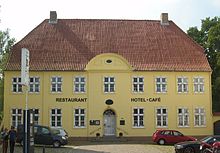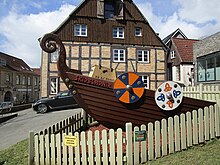Lollipop
The Lollfuß ( Danish Lolfod ) is the name of a street and a district of the city of Schleswig . The district connects the old town of Schleswig in the east with Gottorf Castle in the west. In the south it borders directly on the inner loop , in the north on the Hesterberg ( Hestebjerg ).
history
In the 16th century, the settlement initially only consisted of individual buildings on the connecting route between Schleswig and Gottorf, but was expanded under the influence of the nearby castle in the following decades and eventually developed into a suburb of the neighboring city of Schleswig. In particular servants, craftsmen and artists of the nearby ducal and later royal court settled on the Lollfuß, but also higher court officials settled here - as in Friedrichsberg . In 1711 Schleswig, Friedrichsberg and Lollfuß were finally merged together with the Hesterberg and the hen houses to form the combined city of Schleswig . The Domziegelhof was initially under the administration of the cathedral chapter, but in 1737 it also came under the administration of the city. The Lollfuß became the seventh quarter of the Schleistadt. However, the relationship to the court remained in the period after the merger with the city of Schleswig. After the German-Danish War , the Lollfuß came under German / Prussian rule for the first time.
In the course of the 17th century numerous representative town houses were built on the Lollfuß , which were often characterized by Dutch -influenced baroque facades. The city theater was also located in Lollfuß until its demolition in 2014. The district court in Heespenhof, the old customs house and the Danish cultural center Slesvighus can still be found in Lollfuß today. The lollipop staircase leads up to the adjacent Hesterberg. Not far from the Lollfußes on the Michaelisberg was the former Michaeliskirche, to whose parish ( Michaelis Sogn ) the Lollfuß belonged. The church was the only round church in the Schleswig region before it collapsed in 1870 and was finally demolished in 1871.
Since 2016, as part of a cultural project, several stations have been created in Lollfuß with references to Nordic mythology.
Naming
The origin of the name Lollfuß has not been conclusively clarified. The name could be traced back to springs (Lollen) located on the slope, the Germanic god Lollus or the Catholic saint Lullus .
literature
- Hermann Kelleenbeenz: Schleswig in the Gottorf period 1544–1711 , Society for Schleswig City History, Schleswig 1985.
Individual evidence
- ↑ Alte Schleihalle: Meaning of the street names
- ↑ Hermann Kelleenbeenz: Schleswig in Gottorfer time 1544-1711 , Schleswig 1985, page 63
- ↑ Gerdtams: Around the Michaliskirche
- ↑ Lollfusser Mythenpfad
- ↑ This possibility is assessed as rather unlikely, since the existence of such a god is doubted and this is said to have only been widespread in the Franconian region, but not in the northern European / Jutland region.
- ↑ Pro Lollfuss: The name Lollfuß
- ↑ alte-schleihalle.de: Meaning of the street names
Web links
Coordinates: 54 ° 30 '50.8 " N , 9 ° 32' 52.8" E


